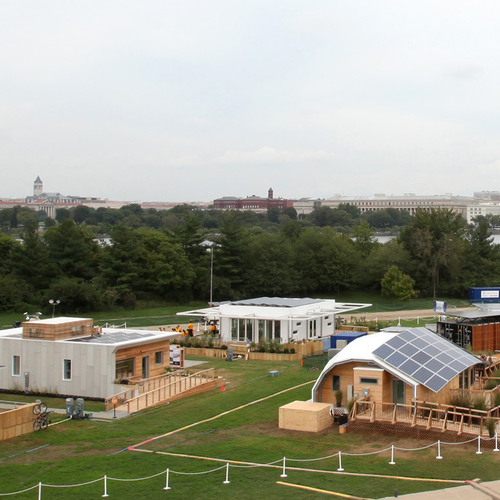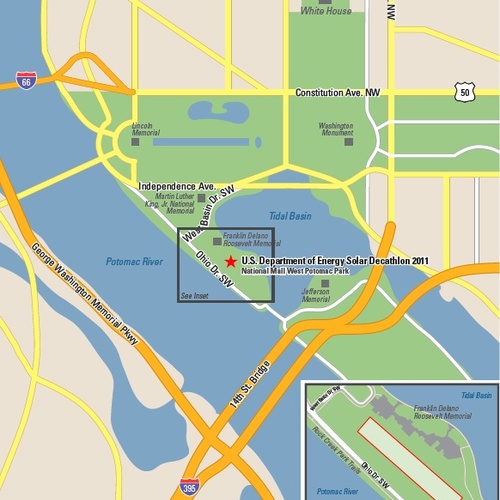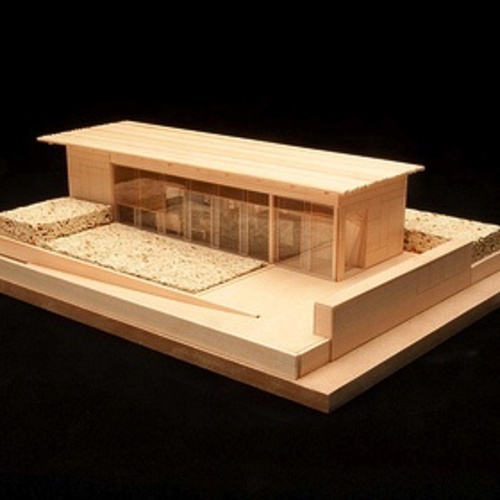
Sometime soon – very soon, the 20 contestants in the 2011 Solar Decathlon hope – the Department of Energy will announce the new location of the Decathlon, whose first four editions, beginning in 2002, were held on the National Mall in Washington, D.C.
The DOE announced on Tuesday that it would move the event to another venue in support of a National Park Service restoration program that is designed to improve and protect the mall. So now, with the 20 teams scheduled to compete in October, the DOE is scrambling.
According to a post by environmental-and-energy-policy media source GreenWire, event organizers are searching for alternate locations in Washington, but also are considering sites in or near cities such as New York, Chicago, Los Angeles, and St. Louis. No small task, given the requirements for tractor-trailer access, temporary-construction accommodations, siting for optimal solar exposure, and cleanup strategies.
Trying to meet expectations and sustain interest
Ideally, of course, the next location, like the mall, would be an established tourist attraction. The 2009 Solar Decathlon drew a lot people to the homes in the competition – 307,502 house visits over 10 days – and offered 32 onsite workshops for the public and a daylong series of workshops for industry professionals that were attended by 506 people.
The GreenWire post noted that possible alternate sites in the D.C. area include National Harbor in suburban Maryland, RFK Stadium in Washington, and the Montgomery County fairgrounds in Maryland. The DOE official directing the event, Richard King, said that a final decision is expected “in the next couple of weeks.”
Understandably, many contestants are disappointed by the location shift. “Like many of the other teams, we’re a little bit concerned,” Johann Kyser, a junior at the University of Calgary and member of Team Canada, told GreenWire. “We’ve made a lot of arrangements based to the fact that it’s going to be on the National Mall.”
In addition to designing and building its entry – a house of no more than 800 sq. ft. that will be judged in 10 contest categories – each team must manage its own fundraising program and handle the logistics of transporting, assembling, and disassembling its entry.
Chip Dence, a member of the National Association of Home Builders who has served as a judge during past Solar Decathlons, added that he has sent a letter to the White House asking President Obama to reverse the DOE’s decision to move the event. “That’s kind of changing the rules in the middle of the game because these teams have already gotten a lot of sponsors who anticipated they were going to displaying their products on the mall,” Dence said. “With an administration where one of their number one priorities is clean energy technologies, it would seem the president should straighten out his boys at [the departments of Interior] and Energy.”
Weekly Newsletter
Get building science and energy efficiency advice, plus special offers, in your inbox.















5 Comments
Change Locations
Wouldn’t be nice if every time they do this event it would change to a different location around the country so many more teams and people have access to view all this new technology?
Yes, except DOE is the host
Yes, except DOE is the host of the event.
Decathalon
Lets put it in the middle so ALL of us could participate (DENVER)
Both
I agree, changing venues is the way to go. In honor of the University of Colorado team that won the First two, the first place it should go is Denver.
Denver it is, then
The biggest change for the better for the decathlon is to build all these homes on a permanent foundation. Most of these homes have gone to waste because of the high cost of moving them to somewhere appropriate and trying to sell it. When they do sell, they've been going for pennies on the dollar. It's not a very green strategy to build a house at a university, pack it and move it thousands of miles, reassemble and commission it, and then do it all over again. Thousands of man-hours would be saved.
The greenest setting of all would be an existing urban neighborhood, near transit, in need of revitalization. Neighborhoods like that often have many city-owned vacant lots.
Log in or create an account to post a comment.
Sign up Log in